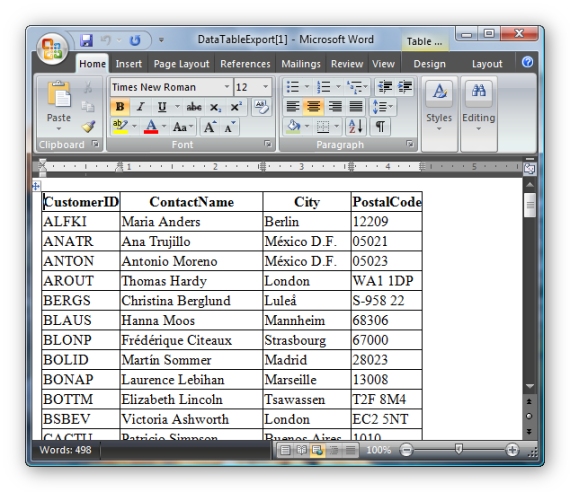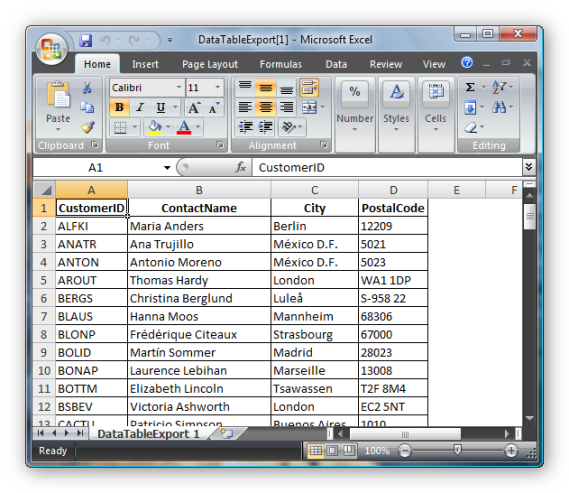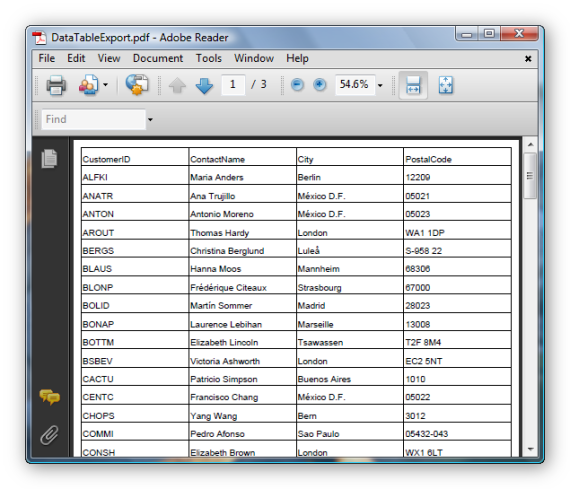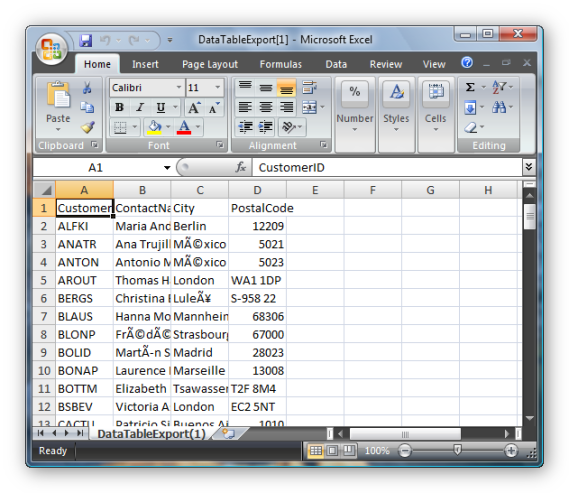You can change a setting in your web.config to allow larger requests.
Here is the example:
1: <configuration>
2: <system.web>
3: <httpRuntime maxRequestLength="4096"/>
4: </system.web>
5: </configuration>
---
Happy Programming
1: <configuration>
2: <system.web>
3: <httpRuntime maxRequestLength="4096"/>
4: </system.web>
5: </configuration>
| Specifier | type | output (June 8, 1970 12:30:59) |
|---|---|---|
| dd | Day | 08 |
| ddd | Short Day Name | Mon |
| dddd | Full Day Name | Monday |
| hh | 2 digit hour | 12 |
| HH | 2 digit hour (24 hour) | 12 |
| mm | 2 digit minute | 30 |
| MM | Month | 06 |
| MMM | Short Month name | Jun |
| MMMM | Month name | June |
| ss | seconds | 59 |
| tt | AM/PM | PM |
| yy | 2 digit year | 70 |
| yyyy | 4 digit year | 1970 |
| : | seperator, e.g. {0:hh:mm:ss} | 12:30:59 |
| / | seperator, e.g. {0:dd/MM/yyyy} | 08/06/1970 |
DateTime dt = DateTime.Now; String strDate=""; strDate = dt.ToString("MM/dd/yyyy"); // 07/21/2007 strDate = dt.ToString("dddd, dd MMMM yyyy"); //Saturday, 21 July 2007 strDate = dt.ToString("dddd, dd MMMM yyyy HH:mm"); // Saturday, 21 July 2007 14:58 strDate = dt.ToString("dddd, dd MMMM yyyy hh:mm tt"); // Saturday, 21 July 2007 03:00 PM strDate = dt.ToString("dddd, dd MMMM yyyy H:mm"); // Saturday, 21 July 2007 5:01 strDate = dt.ToString("dddd, dd MMMM yyyy h:mm tt"); // Saturday, 21 July 2007 3:03 PM strDate = dt.ToString("dddd, dd MMMM yyyy HH:mm:ss"); // Saturday, 21 July 2007 15:04:10 strDate = dt.ToString("MM/dd/yyyy HH:mm"); // 07/21/2007 15:05 strDate = dt.ToString("MM/dd/yyyy hh:mm tt"); // 07/21/2007 03:06 PM strDate = dt.ToString("MM/dd/yyyy H:mm"); // 07/21/2007 15:07 strDate = dt.ToString("MM/dd/yyyy h:mm tt"); // 07/21/2007 3:07 PM strDate = dt.ToString("MM/dd/yyyy HH:mm:ss"); // 07/21/2007 15:09:29 strDate = dt.ToString("MMMM dd"); // July 21 strDate = dt.ToString("yyyy'-'MM'-'dd'T'HH':'mm':'ss.fffffffK"); // 2007-07-21T15:11:19.1250000+05:30 strDate = dt.ToString("ddd, dd MMM yyyy HH':'mm':'ss 'GMT'"); // Sat, 21 Jul 2007 15:12:16 GMT strDate = dt.ToString("yyyy'-'MM'-'dd'T'HH':'mm':'ss"); // 2007-07-21T15:12:57 strDate = dt.ToString("HH:mm"); // 15:14 strDate = dt.ToString("hh:mm tt"); // 03:14 PM strDate = dt.ToString("H:mm"); // 5:15 strDate = dt.ToString("h:mm tt"); // 3:16 PM strDate = dt.ToString("HH:mm:ss"); // 15:16:29 strDate = dt.ToString("yyyy'-'MM'-'dd HH':'mm':'ss'Z'"); // 2007-07-21 15:17:20Z strDate = dt.ToString("dddd, dd MMMM yyyy HH:mm:ss"); // Saturday, 21 July 2007 15:17:58 strDate = dt.ToString("yyyy MMMM"); // 2007 July Hence we can format and getting the datetime value.




<%@ Page Language="VB" AutoEventWireup="false" CodeFile="Default.aspx.vb" Inherits="_Default" %>DOCTYPE html PUBLIC "-//W3C//DTD XHTML 1.0 Transitional//EN" "http://www.w3.org/TR/xhtml1/DTD/xhtml1-transitional.dtd"><html xmlns="http://www.w3.org/1999/xhtml">
<head runat="server">
<title>title>
head><body>
<form id="form1" runat="server">
<div>
<asp:ListView ID="lvwEmployees" runat="server" DataKeyNames="EmployeeID" DataSourceID="SqlDataSourceEmpList">
<ItemTemplate>
<tr>
<td>
<asp:Label ID="EmployeeIDLabel" runat="server" Text='<%# Eval("EmployeeID") %>' />
td><td>
<asp:Label ID="LastNameLabel" runat="server" Text='<%# Eval("LastName") %>' />
td><td>
<asp:Label ID="FirstNameLabel" runat="server" Text='<%# Eval("FirstName") %>' />
td><td>
<asp:Label ID="TitleLabel" runat="server" Text='<%# Eval("Title") %>' />
td><td>
<asp:Button ID="SelectButton" runat="server" Text="Select" CommandName="Select" />
td>tr>ItemTemplate><SelectedItemTemplate>
<tr style="background-color: yellow; font-weight: bold;">
<td>
<asp:Label ID="EmployeeIDLabel" runat="server" Text='<%# Eval("EmployeeID") %>' />
td><td>
<asp:Label ID="LastNameLabel" runat="server" Text='<%# Eval("LastName") %>' />
td><td>
<asp:Label ID="FirstNameLabel" runat="server" Text='<%# Eval("FirstName") %>' />
td><td>
<asp:Label ID="TitleLabel" runat="server" Text='<%# Eval("Title") %>' />
td>tr>SelectedItemTemplate><LayoutTemplate>
<table runat="server">
<tr runat="server">
<td runat="server">
<table id="itemPlaceholderContainer" runat="server" border="1" style="border-collapse: collapse;
border-width: 1px;"><tr runat="server" style="background-color: #DCDCDC; color: #000000;">
<th runat="server">
EmployeeID
th><th runat="server">
LastName
th><th runat="server">
FirstName
th><th runat="server">
Title
th>tr><tr id="itemPlaceholder" runat="server">
tr>table>td>tr>table>LayoutTemplate>asp:ListView> <asp:SqlDataSource ID="SqlDataSourceEmpList" runat="server" ConnectionString="<%$ ConnectionStrings:NorthwindConnectionString %>"
SelectCommand="SELECT [EmployeeID], [LastName], [FirstName], [Title] FROM [Employees] ORDER BY [EmployeeID]">
asp:SqlDataSource><br />
<asp:DetailsView ID="dvwEmployee" runat="server" DataSourceID="SqlDataSourceEmp"
AutoGenerateRows="False" DataKeyNames="EmployeeID">
<Fields>
<asp:BoundField DataField="EmployeeID" HeaderText="EmployeeID" InsertVisible="False"
ReadOnly="True" SortExpression="EmployeeID" />
<asp:BoundField DataField="LastName" HeaderText="LastName" SortExpression="LastName" />
<asp:BoundField DataField="FirstName" HeaderText="FirstName" SortExpression="FirstName" />
<asp:BoundField DataField="Title" HeaderText="Title" SortExpression="Title" />
<asp:CommandField ShowDeleteButton="True" ShowEditButton="True" ShowInsertButton="True"
NewText="Add" ButtonType="Button" />
Fields>asp:DetailsView><asp:SqlDataSource ID="SqlDataSourceEmp" runat="server" ConnectionString="<%$ ConnectionStrings:NorthwindConnectionString %>"
DeleteCommand="DELETE FROM [Employees] WHERE [EmployeeID] = @EmployeeID" InsertCommand="INSERT INTO [Employees] ([LastName], [FirstName], [Title]) VALUES (@LastName, @FirstName, @Title)"
SelectCommand="SELECT [EmployeeID], [LastName], [FirstName], [Title] FROM [Employees] WHERE ([EmployeeID] = @EmployeeID)"
UpdateCommand="UPDATE [Employees] SET [LastName] = @LastName, [FirstName] = @FirstName, [Title] = @Title WHERE [EmployeeID] = @EmployeeID">
<SelectParameters>
<asp:ControlParameter ControlID="lvwEmployees" Name="EmployeeID" PropertyName="SelectedValue"
Type="Int32" />
SelectParameters><DeleteParameters>
<asp:Parameter Name="EmployeeID" Type="Int32" />
DeleteParameters><UpdateParameters>
<asp:Parameter Name="LastName" Type="String" />
<asp:Parameter Name="FirstName" Type="String" />
<asp:Parameter Name="Title" Type="String" />
<asp:Parameter Name="EmployeeID" Type="Int32" />
UpdateParameters><InsertParameters>
<asp:Parameter Name="LastName" Type="String" />
<asp:Parameter Name="FirstName" Type="String" />
<asp:Parameter Name="Title" Type="String" />
InsertParameters>asp:SqlDataSource> div>form>body>html>
BEGIN TRY BEGIN TRAN --put queries here COMMIT; END TRY BEGIN CATCH IF @@TRANCOUNT>0 BEGIN SELECT @@ERROR,ERRO...